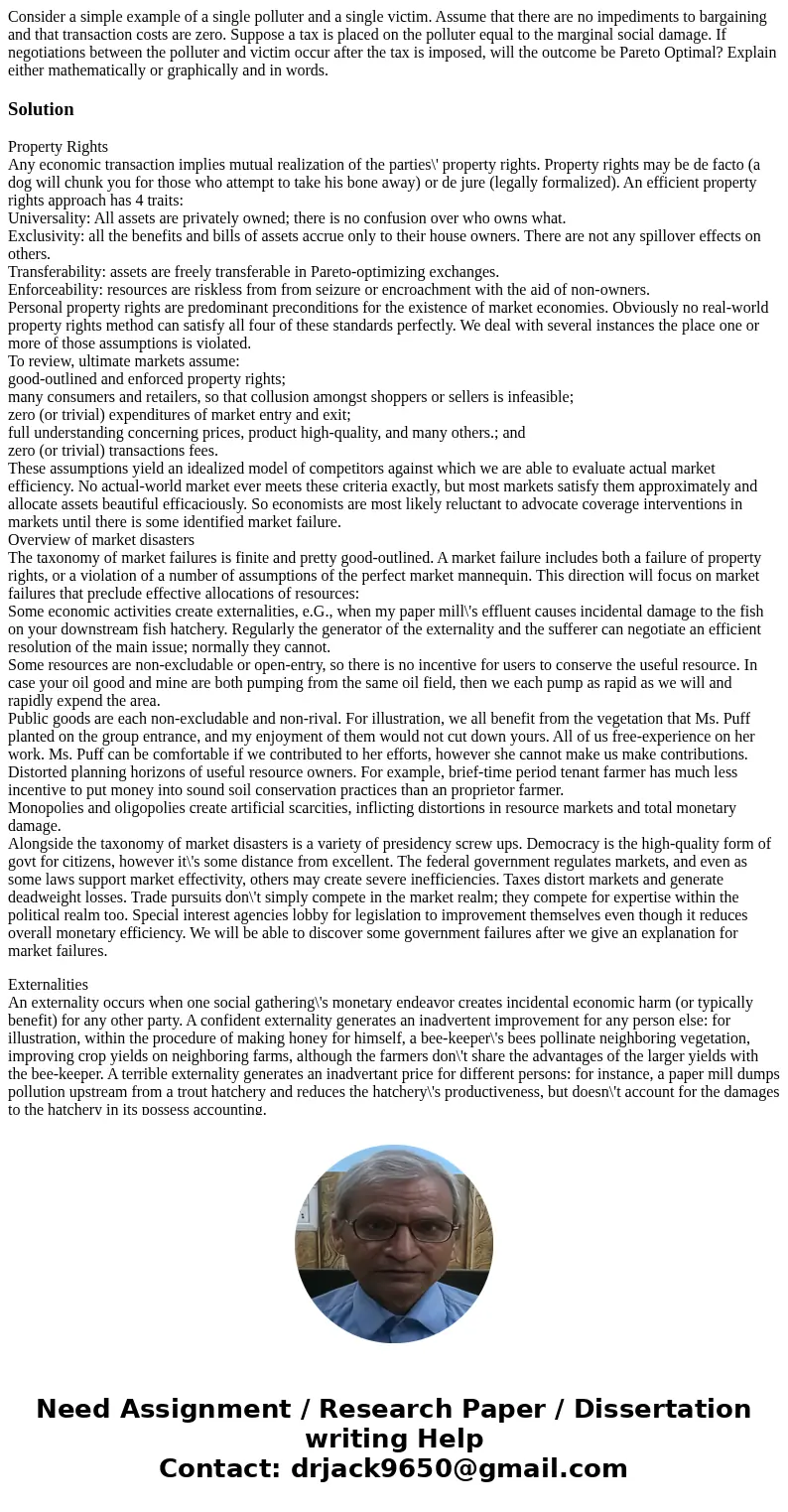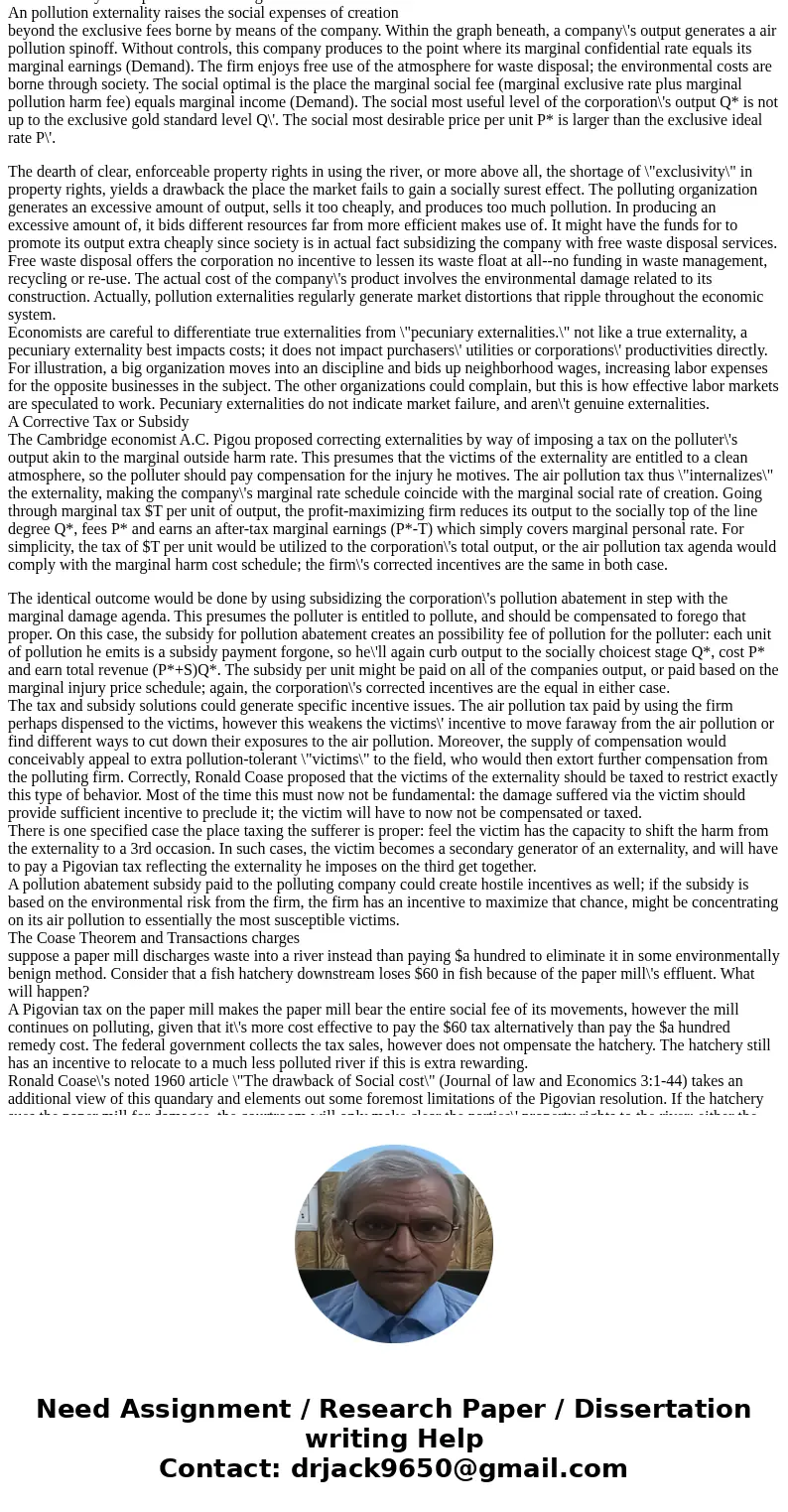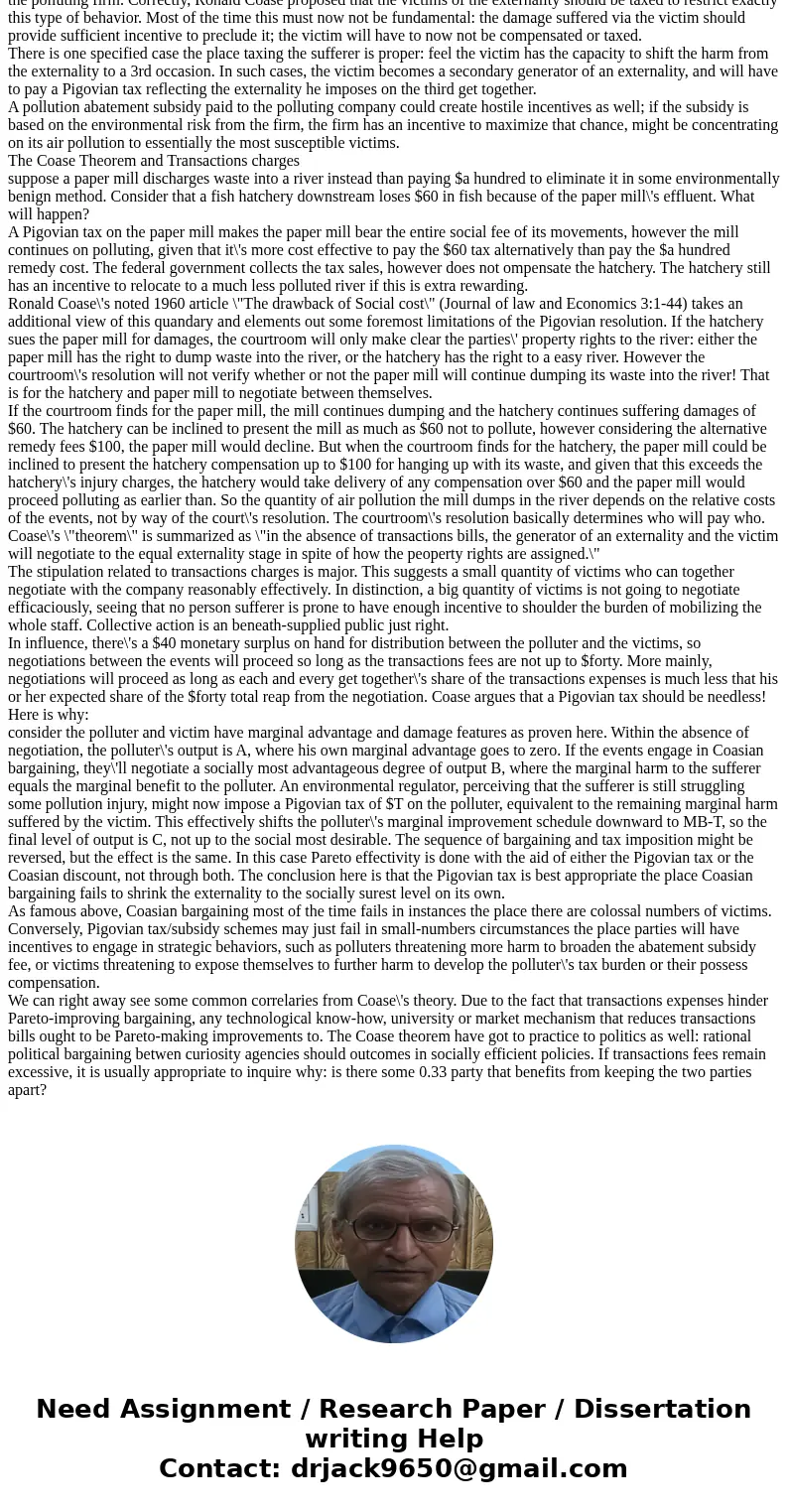Consider a simple example of a single polluter and a single
Consider a simple example of a single polluter and a single victim. Assume that there are no impediments to bargaining and that transaction costs are zero. Suppose a tax is placed on the polluter equal to the marginal social damage. If negotiations between the polluter and victim occur after the tax is imposed, will the outcome be Pareto Optimal? Explain either mathematically or graphically and in words.
Solution
Property Rights
Any economic transaction implies mutual realization of the parties\' property rights. Property rights may be de facto (a dog will chunk you for those who attempt to take his bone away) or de jure (legally formalized). An efficient property rights approach has 4 traits:
Universality: All assets are privately owned; there is no confusion over who owns what.
Exclusivity: all the benefits and bills of assets accrue only to their house owners. There are not any spillover effects on others.
Transferability: assets are freely transferable in Pareto-optimizing exchanges.
Enforceability: resources are riskless from from seizure or encroachment with the aid of non-owners.
Personal property rights are predominant preconditions for the existence of market economies. Obviously no real-world property rights method can satisfy all four of these standards perfectly. We deal with several instances the place one or more of those assumptions is violated.
To review, ultimate markets assume:
good-outlined and enforced property rights;
many consumers and retailers, so that collusion amongst shoppers or sellers is infeasible;
zero (or trivial) expenditures of market entry and exit;
full understanding concerning prices, product high-quality, and many others.; and
zero (or trivial) transactions fees.
These assumptions yield an idealized model of competitors against which we are able to evaluate actual market efficiency. No actual-world market ever meets these criteria exactly, but most markets satisfy them approximately and allocate assets beautiful efficaciously. So economists are most likely reluctant to advocate coverage interventions in markets until there is some identified market failure.
Overview of market disasters
The taxonomy of market failures is finite and pretty good-outlined. A market failure includes both a failure of property rights, or a violation of a number of assumptions of the perfect market mannequin. This direction will focus on market failures that preclude effective allocations of resources:
Some economic activities create externalities, e.G., when my paper mill\'s effluent causes incidental damage to the fish on your downstream fish hatchery. Regularly the generator of the externality and the sufferer can negotiate an efficient resolution of the main issue; normally they cannot.
Some resources are non-excludable or open-entry, so there is no incentive for users to conserve the useful resource. In case your oil good and mine are both pumping from the same oil field, then we each pump as rapid as we will and rapidly expend the area.
Public goods are each non-excludable and non-rival. For illustration, we all benefit from the vegetation that Ms. Puff planted on the group entrance, and my enjoyment of them would not cut down yours. All of us free-experience on her work. Ms. Puff can be comfortable if we contributed to her efforts, however she cannot make us make contributions.
Distorted planning horizons of useful resource owners. For example, brief-time period tenant farmer has much less incentive to put money into sound soil conservation practices than an proprietor farmer.
Monopolies and oligopolies create artificial scarcities, inflicting distortions in resource markets and total monetary damage.
Alongside the taxonomy of market disasters is a variety of presidency screw ups. Democracy is the high-quality form of govt for citizens, however it\'s some distance from excellent. The federal government regulates markets, and even as some laws support market effectivity, others may create severe inefficiencies. Taxes distort markets and generate deadweight losses. Trade pursuits don\'t simply compete in the market realm; they compete for expertise within the political realm too. Special interest agencies lobby for legislation to improvement themselves even though it reduces overall monetary efficiency. We will be able to discover some government failures after we give an explanation for market failures.
Externalities
An externality occurs when one social gathering\'s monetary endeavor creates incidental economic harm (or typically benefit) for any other party. A confident externality generates an inadvertent improvement for any person else: for illustration, within the procedure of making honey for himself, a bee-keeper\'s bees pollinate neighboring vegetation, improving crop yields on neighboring farms, although the farmers don\'t share the advantages of the larger yields with the bee-keeper. A terrible externality generates an inadvertant price for different persons: for instance, a paper mill dumps pollution upstream from a trout hatchery and reduces the hatchery\'s productiveness, but doesn\'t account for the damages to the hatchery in its possess accounting.
An pollution externality raises the social expenses of creation
beyond the exclusive fees borne by means of the company. Within the graph beneath, a company\'s output generates a air pollution spinoff. Without controls, this company produces to the point where its marginal confidential rate equals its marginal earnings (Demand). The firm enjoys free use of the atmosphere for waste disposal; the environmental costs are borne through society. The social optimal is the place the marginal social fee (marginal exclusive rate plus marginal pollution harm fee) equals marginal income (Demand). The social most useful level of the corporation\'s output Q* is not up to the exclusive gold standard level Q\'. The social most desirable price per unit P* is larger than the exclusive ideal rate P\'.
The dearth of clear, enforceable property rights in using the river, or more above all, the shortage of \"exclusivity\" in property rights, yields a drawback the place the market fails to gain a socially surest effect. The polluting organization generates an excessive amount of output, sells it too cheaply, and produces too much pollution. In producing an excessive amount of, it bids different resources far from more efficient makes use of. It might have the funds for to promote its output extra cheaply since society is in actual fact subsidizing the company with free waste disposal services. Free waste disposal offers the corporation no incentive to lessen its waste float at all--no funding in waste management, recycling or re-use. The actual cost of the company\'s product involves the environmental damage related to its construction. Actually, pollution externalities regularly generate market distortions that ripple throughout the economic system.
Economists are careful to differentiate true externalities from \"pecuniary externalities.\" not like a true externality, a pecuniary externality best impacts costs; it does not impact purchasers\' utilities or corporations\' productivities directly. For illustration, a big organization moves into an discipline and bids up neighborhood wages, increasing labor expenses for the opposite businesses in the subject. The other organizations could complain, but this is how effective labor markets are speculated to work. Pecuniary externalities do not indicate market failure, and aren\'t genuine externalities.
A Corrective Tax or Subsidy
The Cambridge economist A.C. Pigou proposed correcting externalities by way of imposing a tax on the polluter\'s output akin to the marginal outside harm rate. This presumes that the victims of the externality are entitled to a clean atmosphere, so the polluter should pay compensation for the injury he motives. The air pollution tax thus \"internalizes\" the externality, making the company\'s marginal rate schedule coincide with the marginal social rate of creation. Going through marginal tax $T per unit of output, the profit-maximizing firm reduces its output to the socially top of the line degree Q*, fees P* and earns an after-tax marginal earnings (P*-T) which simply covers marginal personal rate. For simplicity, the tax of $T per unit would be utilized to the corporation\'s total output, or the air pollution tax agenda would comply with the marginal harm cost schedule; the firm\'s corrected incentives are the same in both case.
The identical outcome would be done by using subsidizing the corporation\'s pollution abatement in step with the marginal damage agenda. This presumes the polluter is entitled to pollute, and should be compensated to forego that proper. On this case, the subsidy for pollution abatement creates an possibility fee of pollution for the polluter: each unit of pollution he emits is a subsidy payment forgone, so he\'ll again curb output to the socially choicest stage Q*, cost P* and earn total revenue (P*+S)Q*. The subsidy per unit might be paid on all of the companies output, or paid based on the marginal injury price schedule; again, the corporation\'s corrected incentives are the equal in either case.
The tax and subsidy solutions could generate specific incentive issues. The air pollution tax paid by using the firm perhaps dispensed to the victims, however this weakens the victims\' incentive to move faraway from the air pollution or find different ways to cut down their exposures to the air pollution. Moreover, the supply of compensation would conceivably appeal to extra pollution-tolerant \"victims\" to the field, who would then extort further compensation from the polluting firm. Correctly, Ronald Coase proposed that the victims of the externality should be taxed to restrict exactly this type of behavior. Most of the time this must now not be fundamental: the damage suffered via the victim should provide sufficient incentive to preclude it; the victim will have to now not be compensated or taxed.
There is one specified case the place taxing the sufferer is proper: feel the victim has the capacity to shift the harm from the externality to a 3rd occasion. In such cases, the victim becomes a secondary generator of an externality, and will have to pay a Pigovian tax reflecting the externality he imposes on the third get together.
A pollution abatement subsidy paid to the polluting company could create hostile incentives as well; if the subsidy is based on the environmental risk from the firm, the firm has an incentive to maximize that chance, might be concentrating on its air pollution to essentially the most susceptible victims.
The Coase Theorem and Transactions charges
suppose a paper mill discharges waste into a river instead than paying $a hundred to eliminate it in some environmentally benign method. Consider that a fish hatchery downstream loses $60 in fish because of the paper mill\'s effluent. What will happen?
A Pigovian tax on the paper mill makes the paper mill bear the entire social fee of its movements, however the mill continues on polluting, given that it\'s more cost effective to pay the $60 tax alternatively than pay the $a hundred remedy cost. The federal government collects the tax sales, however does not ompensate the hatchery. The hatchery still has an incentive to relocate to a much less polluted river if this is extra rewarding.
Ronald Coase\'s noted 1960 article \"The drawback of Social cost\" (Journal of law and Economics 3:1-44) takes an additional view of this quandary and elements out some foremost limitations of the Pigovian resolution. If the hatchery sues the paper mill for damages, the courtroom will only make clear the parties\' property rights to the river: either the paper mill has the right to dump waste into the river, or the hatchery has the right to a easy river. However the courtroom\'s resolution will not verify whether or not the paper mill will continue dumping its waste into the river! That is for the hatchery and paper mill to negotiate between themselves.
If the courtroom finds for the paper mill, the mill continues dumping and the hatchery continues suffering damages of $60. The hatchery can be inclined to present the mill as much as $60 not to pollute, however considering the alternative remedy fees $100, the paper mill would decline. But when the courtroom finds for the hatchery, the paper mill could be inclined to present the hatchery compensation up to $100 for hanging up with its waste, and given that this exceeds the hatchery\'s injury charges, the hatchery would take delivery of any compensation over $60 and the paper mill would proceed polluting as earlier than. So the quantity of air pollution the mill dumps in the river depends on the relative costs of the events, not by way of the court\'s resolution. The courtroom\'s resolution basically determines who will pay who.
Coase\'s \"theorem\" is summarized as \"in the absence of transactions bills, the generator of an externality and the victim will negotiate to the equal externality stage in spite of how the peoperty rights are assigned.\"
The stipulation related to transactions charges is major. This suggests a small quantity of victims who can together negotiate with the company reasonably effectively. In distinction, a big quantity of victims is not going to negotiate efficaciously, seeing that no person sufferer is prone to have enough incentive to shoulder the burden of mobilizing the whole staff. Collective action is an beneath-supplied public just right.
In influence, there\'s a $40 monetary surplus on hand for distribution between the polluter and the victims, so negotiations between the events will proceed so long as the transactions fees are not up to $forty. More mainly, negotiations will proceed as long as each and every get together\'s share of the transactions expenses is much less that his or her expected share of the $forty total reap from the negotiation. Coase argues that a Pigovian tax should be needless! Here is why:
consider the polluter and victim have marginal advantage and damage features as proven here. Within the absence of negotiation, the polluter\'s output is A, where his own marginal advantage goes to zero. If the events engage in Coasian bargaining, they\'ll negotiate a socially most advantageous degree of output B, where the marginal harm to the sufferer equals the marginal benefit to the polluter. An environmental regulator, perceiving that the sufferer is still struggling some pollution injury, might now impose a Pigovian tax of $T on the polluter, equivalent to the remaining marginal harm suffered by the victim. This effectively shifts the polluter\'s marginal improvement schedule downward to MB-T, so the final level of output is C, not up to the social most desirable. The sequence of bargaining and tax imposition might be reversed, but the effect is the same. In this case Pareto effectivity is done with the aid of either the Pigovian tax or the Coasian discount, not through both. The conclusion here is that the Pigovian tax is best appropriate the place Coasian bargaining fails to shrink the externality to the socially surest level on its own.
As famous above, Coasian bargaining most of the time fails in instances the place there are colossal numbers of victims. Conversely, Pigovian tax/subsidy schemes may just fail in small-numbers circumstances the place parties will have incentives to engage in strategic behaviors, such as polluters threatening more harm to broaden the abatement subsidy fee, or victims threatening to expose themselves to further harm to develop the polluter\'s tax burden or their possess compensation.
We can right away see some common correlaries from Coase\'s theory. Due to the fact that transactions expenses hinder Pareto-improving bargaining, any technological know-how, university or market mechanism that reduces transactions bills ought to be Pareto-making improvements to. The Coase theorem have got to practice to politics as well: rational political bargaining betwen curiosity agencies should outcomes in socially efficient policies. If transactions fees remain excessive, it is usually appropriate to inquire why: is there some 0.33 party that benefits from keeping the two parties apart?



 Homework Sourse
Homework Sourse